The Aspermühle - Through the ages
The Aspermühle can look back on a long tradition and has been situated below the Asperberg to the right of the Niers in Asperden near Goch for almost 8 centuries and thus nestles south of the Reichswald against the Lower Rhine range of hills.
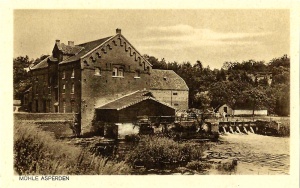
Aspermühle 20s
The Aspermühle - location and surroundings:
It thus joins a group of historic buildings in the immediate vicinity.
Particularly worth mentioning here are the Burgus near Asperden, the fort at Goch, Haus Driesberg and, of course, the Rott Castle from which the Graefenthal Monastery later emerged, which is historically closely linked to the Aspermühle.
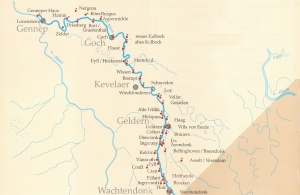
Historical buildings on the Lower Rhine
The older history of the Aspermühle:
The first documentary mention of the mill located in Asperden is in 1301, with the introductory sentence "In nomini domini amen" - "In the name of the Lord Amen", which was usual for documents at that time.
With this document, on May 18, the Julian calendar in use at that time, the Aspermühle on the Niers, which rises in the Jülicher Börde near the town of Erkelenz and flows into the Maas, was donated by Count Reinald I of Geldern and Duke of Limburg to the Cistercian abbey of Graefenthal, 15 minutes downstream, where he was also buried in 1326.
Video about the Graefenthal Abbey
However, it can be assumed that the mill has a much older history, as it was already being run as a leasehold property before the donation by Graefenthal Abbey, which was founded in 1248. The Graefenthal Monastery and the Asperden Mill were closely connected from the beginning, as the monastery was also founded by one of the Counts of Guelders. Namely Otto II of Guelders, the father of Reinald I. He was also called Otto the Lame or Otto with the Horse's Foot, was one of the most influential princes in the entire Lower Rhine area and was even considered a promising candidate for the throne for a while.
Among other things, he received Emmerich and Nijmegen from William of Holland as imperial bailiwicks and had the latter expanded into a residence.
However, the nuns did not run the mill themselves, but originally leased it to the von Wachtendonk family, who in turn had it run by their head miller (molenmeester).
Unlike the surrounding mills in the region, the Aspermühle was not subject to the Mühlenzwang (Mühlenbann) enacted by Frederick I (Barbarossa) in 1158, because it was directly affiliated with the abbey and was only allowed to grind for it. The mill constraint meant that the subjects of a certain landlord were only allowed to have their grain ground in a certain mill. On the one hand, this prevented competition between millers and, on the other, ensured the miller a regular income. Sometimes, however, this also invited abuse, because it was up to the miller whose grain was milled first. So sometimes it was rather the highest bidder who decided whose turn it was to grind next.
Since the exclusive grinding for the Graefenthal monastery could not be economically viable in the long run for the Aspermühle, a second area of work, the fulling operation, was also taken up there.
Fulling, a type of felting, was originally done by hand, or rather by foot, by rubbing woollen cloth over a fulling board with the feet. In this way the fabric felted on the surface, making it denser and warmer and to some extent water repellent.
A fulling mill, which could work cloth tirelessly on a large scale with the help of hammers, usually replaced up to 40 foot-walkers and was therefore not without controversy, as jobs were lost here due to mechanisation.
In the 16th century, another branch of work was also developed via a tan mill. A tan mill was used for the extraction of vegetable tanning agents, mainly from oak bark. Thus the location at the Reichswald was naturally optimal, for the extraction of the necessary raw material.
Unfortunately, the mill trade of the Aspermühle came to a temporary inglorious end in 1595. In the turmoil of the 80-year war(Spanish-Dutch War), which was also overshadowed by the 30-year war, the entire region of the Lower Rhine was badly affected and devastated to a large extent.
The Aspermühle and the van de Loo family:
Thus, according to family lore of the van de Loo family, the Aspermühle, like many other leased properties of the Graefenthal monastery, also fell victim to a major fire. Due to this circumstance, the monastery lacked the necessary financial means to rebuild the mill and therefore it was decided to give the mill to a financially stronger investor on a leasehold basis, who had the necessary means to rebuild the mill.
The new leaseholder and manager was Hendrick van Loe, whose family branch goes back to Bruen van den Loe (van Abroeck)(ca. 1445 - ca. 1509), judge of Weeze. Bruen was an illigitimate son of Heijlken van Abroeck and knight Johan von Loe, who was court master to the Duke of Kleve and also bought Wissen Castle in Weeze, which is still the residence of the Von Loë family.
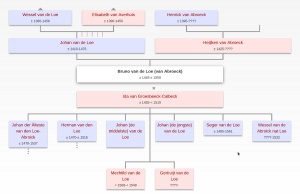
Family tree Bruen van de Loe
Bruen's descendant Hendrick van Loe married the then daughter of the master miller Hendrick Ver, Mrs Engelberta Ver. The entire line of the van de Loo's of Asperden thus goes back to Hendrick and Engelberta van Loe.
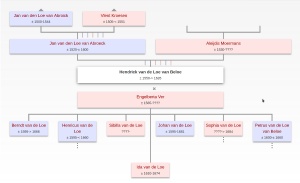
Family tree Hendrick van de Loo
With the takeover of the mill the new tenant and miller concluded a direct contract with the Graefenthal monastery, so that no additional payments had to be made to an intermediate tenant, as had previously been the case with the von Wachtendonk family.
Since the right to use the Niers also included a fishing right, the lease was to be paid to the monastery in the form of deliveries of flour and fish.
After the 30- and 80-year wars had ended and the mill had been rebuilt, the mill trade was continued on a leasehold basis for almost 200 years until the Aspermühle was bought by Engelbert van de Loo (1778 - 1833) in 1805 in the course of the Napoleonic secularisation.
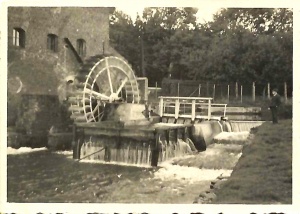
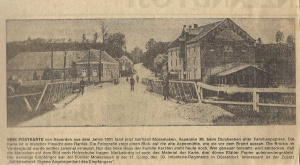
15 years later the fulling operation was discontinued, as it was probably no longer economically viable.
On the one hand, the cotton industry experienced an enormous boom at the end of the 18th century until the beginning of the 19th century, as it was able to produce much more cheaply due to the cheap extraction of raw materials through slavery and the beginning of industrialisation, with automated yarn spinning and weaving.
On the other hand, automation was also introduced in the wool spinning and weaving industry. This meant that wool was no longer processed by hand, but by machines in large cities and industrial centres.
This made individual processing steps such as fulling in rural areas clearly unprofitable and intensified the decline of the wool industry in structurally weak areas, which began at the beginning of the 19th century.
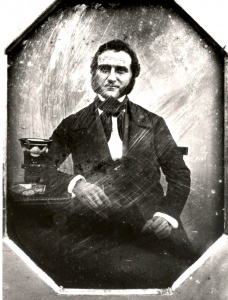
From 1833 the mill was taken over and continued by Wilhelm van de Loo, mayor of Asperden and Kessel.
Here is a picture from 1850.
Since the van de Loo's were quite enterprising, they expanded the mill operation in 1864 with another mill wheel, which powered an oil press and a gang saw.
As Asperden is situated directly at the Reichswald, the acquisition of the saw must have made sense, as there were large quantities of wood available here due to the forestry.
Video frame saw
Unfortunately, this expansion was not completely free of conflict, as more and more farmers complained about the constant flooding of their fields due to the necessary two-stage damming of the water.
This conflict finally ended before the Reichsgericht in Leipzig and was decided in favour of the van de Loo family, as it could be proven that due to the use of two mill wheels, the strong damming was necessary.
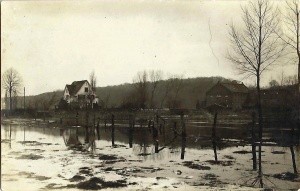
Flooding of the Niers meadows
The mill trade could therefore continue undisturbed for the time being, until in 1932, due to the straightening of the Niers, the mills had to be converted to electric drive.
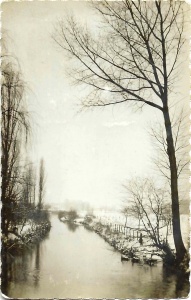
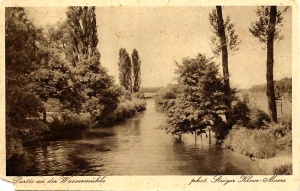
Niers river course in its natural state, before straightening.
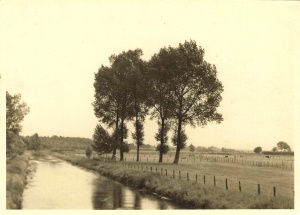
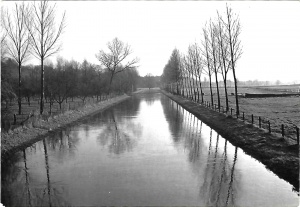
Niers river course after straightening
Fortunately, the Aspermühle survived the turmoil of the 2nd World War without damage, although the Lower Rhine was heavily fought over.
The mill fire in 1959:
It is all the more regrettable that it fell victim to another devastating fire in 1959.
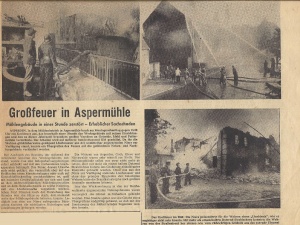
Newspaper clipping fire Aspermühle
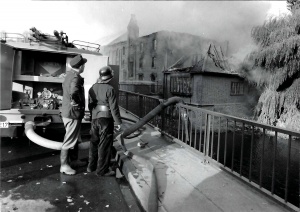
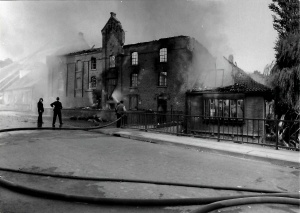
Extinguishing work at the Aspermühle
History of the Aspermühle after 1959:
Although the mill building was subsequently rebuilt in its original form, milling operations were nevertheless discontinued due to the 1957 Mill Act, which primarily affected small and medium-sized mills.
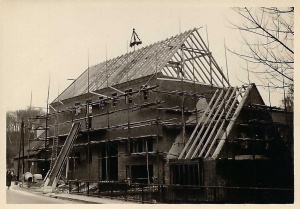
Reconstruction of the Aspermühle
As there was a significant surplus of mills in Germany, mill owners were paid compensation in return for shutting down their mill for 30 years.
After that, the Aspermühle's operations were limited to animal feed production and grain trading until 1975.
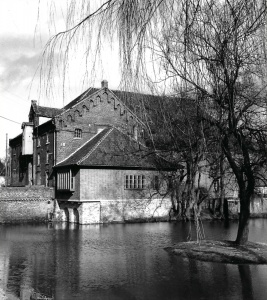
Aspermühle before the fire
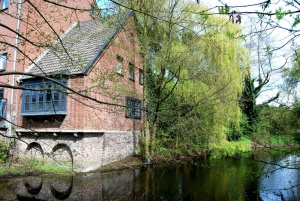
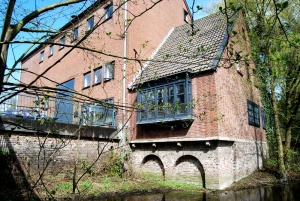
Aspermill today
But also afterwards the mill building was used further. First by the cocoa trader Evers, who still lives in Goch. Later a bookshop was run by a family member.
After the mill stood empty for a few years, it has been enjoying brisk activity again since 2009, as naturwaren-niederrhein GmbH has its headquarters here and sells high-quality organic food from there.
Since then, extensive restoration work has been carried out, including renewing the roof truss and roofing and restoring the old wheelhouse and warehouse to their former glory.